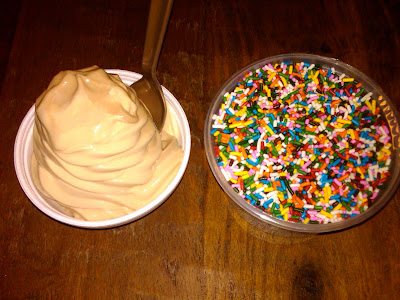But don't be intimidated: you don't have to sit down to a large meal, eat breakfast-y food, or give up your quick morning routine to be considered a Breakfast Eater. Eating breakfast just means getting something into your body within 1-2 hours of waking up. Here are some examples of healthy breakfasts, all between 200-300 calories (approx) each:
If you like breakfast, but you're in a hurry in the morning, try these on-the-go options:
- Spread 1 dollop peanut butter on a whole wheat tortilla, layer with sliced apples or bananas, and roll into a burrito
- 1 Luna bar (Nutz Over Chocolate is my fave) + 1 large orange
- Small baggie of whole grain cereal (try Kashi Heart-to-Heart or Barbara's Cinnamon Puffins) + 6oz container of yogurt (for good yogurts, see my yogurt post)
- 5oz container 0% Greek yogurt w/ small handful dried cranberries & chopped walnuts
- 1 hard boiled egg + 1 piece whole grain toast (try Milton's 100% whole wheat, Milton's Healthy Dark, or When Pigs Fly whole wheat)
- Good old PB+J on whole wheat (eat half for breakfast, half for mid-morning snack)
- Glass of low-fat chocolate milk + 15 almonds
- 2 Kashi GoLean frozen waffles, toasted
- Breakfast burrito made with 1 steamed egg (scramble an egg in a mug and microwave 45-60 seconds or until fluffy), 1/4 cup reduced-fat cheddar, 2 Tbsp salsa
- Quesadilla made with 2 corn tortillas and 1/4 cup reduced-fat cheese, toasted in toaster oven then pressed together
- Kashi TLC Crunchy Granola Bar (Toasted Almond and Pumpkin Spice Flax are both delish) + cup of coffee with milk
- Starbucks Tall Nonfat Latte (unsweetened, or sweetened w/ 1 pkt sugar or Splenda) + 1/2 an Eight grain roll
- Starbucks spinach-tomato-egg wrap + Tall coffee with low-fat milk
- Dunkin Donuts Egg white-veggie flatbread + small coffee w/ low-fat milk
- Dunkin Donuts glazed donut + small nonfat latte (please note: I do not suggest you eat donuts for breakfast, but if you're already going to eat something at Dunkin' Donuts, it's one of the lower-calorie options, and if it prevents you from binging at lunch then go for it)
- Coffee Bean Medium Sugar-Free Vanilla or Mocha Ice Blended
- Coffee Bean Medium Sugar-Free Tea Latte
- McDonald's Egg McMuffin w/ no butter + small coffee
- McDonald's Medium Nonfat Latte w/ 2 pkts sugar
- Jamba Juice 12oz Sunrise Strawberry yogurt blend (ask for 3 scoops ice if you want it thick like a regular Jamba smoothie)
- Jamba Juice oatmeal with fruit topping
- 16 Kashi TLC crackers + 2 wedges Laughing Cow Light cheese
- Large orange + 1 string cheese
- 2 pieces smoked salmon + 1 Tbsp light cream cheese + 7 Reduced-Fat Triscuits
- 2 slices deli turkey breast, cut into strips and wrapped around carrot sticks
- 2 individual containers applesauce + 10 walnut halves
- Apple slices dipped in 1 individual container Kozy Shack chocolate pudding
- 1 SoyJoy bar + large apple
- Small carton of low-fat chocolate milk
- 1/2 Avocado with dollop of salsa
- 2 Kashi GoLean waffles spread with 1 tsp peanut butter each, topped w/ sliced bananas
- 1 whole wheat English Muffin with 1/2 cup cottage cheese and sliced tomatoes
- 1/2 whole wheat bagel with 1 Tbsp Light cream cheese and 1 tsp fruit preserves
- 1/2 cup cottage cheese layered with 1 cup berries, drizzled with honey & 2 Tbsp chopped nuts
- Bowl of 1 cup plain nonfat yogurt, 1 cup chopped fruit (try thawed frozen mango in winter) and 1/4 cup granola
- 2 poached eggs w/ 1 sliced whole wheat toast spread w/ 1 tsp Smart Balance Light
- Banana Oat Smoothie (click here for recipe)
- Berry Smoothie, made with 1 1/2 cups frozen berries + 1/2 cup plain yogurt + 1/2 cup soy milk
- 2 corn tortillas topped with 1/4 cup reduced-fat cheese, melted in microwave or skillet and topped with salsa and chopped tomatoes
- 1/2 cup (dry) oat bran cereal, microwaved with 1 cup water then topped with sliced banana, drizzle of honey, and 1/2 cup vanilla soymilk
- Homemade McMuffin - 1 toasted whole wheat English Muffin +1 steamed egg (scramble an egg in a mug and microwave 45-60 seconds or until fluffy) +1 slice 2% American or Cheddar Cheese + 2 tomato slices
- 1 piece whole wheat sourdough toast with 1 Tbsp light cream cheese, cucumber slices, and few pieces smoked salmon















